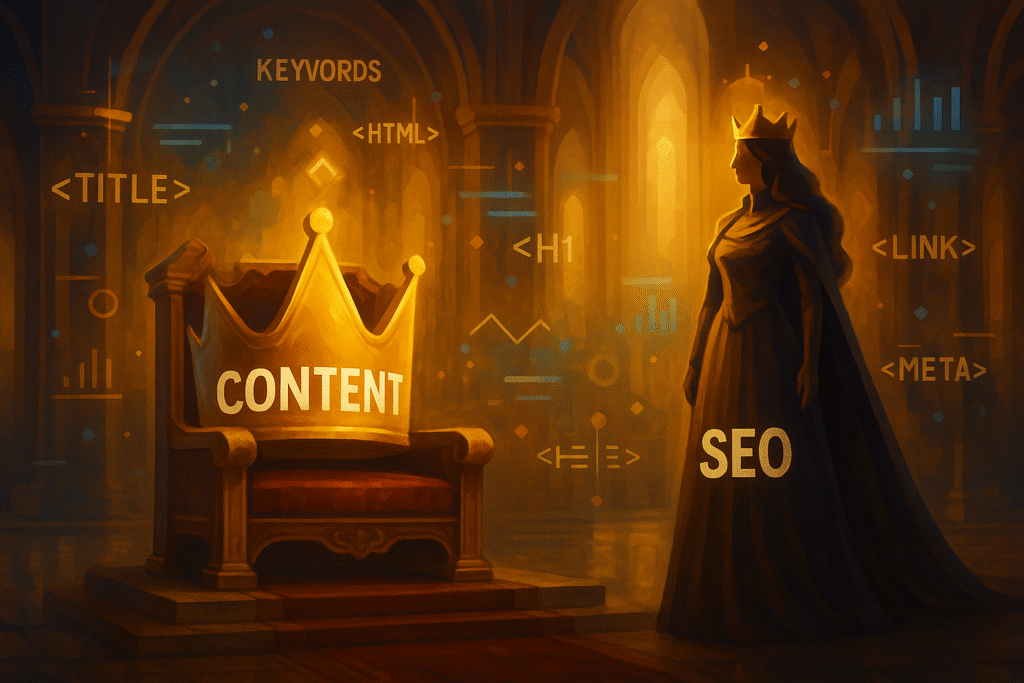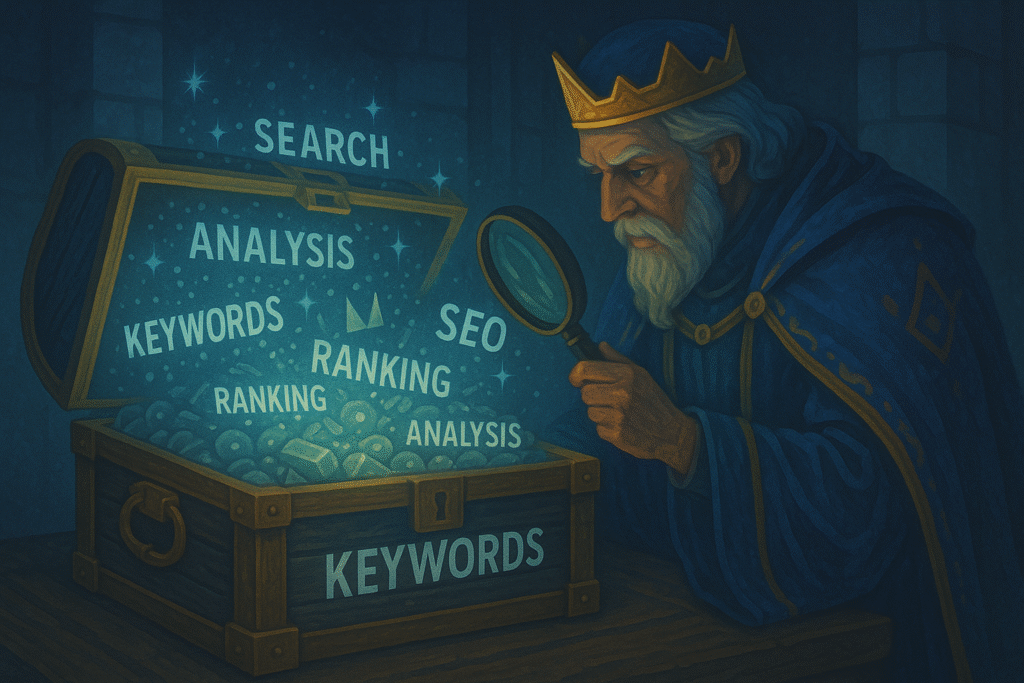Introduction: Rethinking the Content vs. SEO Debate
Have you ever heard the saying “Content is king”? Certainly, you have. But here is the twist—even the most powerful king needs a queen to rule effectively. And in the realm of digital marketing, that queen is on-page SEO.
Today, we’re going deep into how content and optimization go hand in hand like royalty, ruling over rankings, traffic, and engagement. And if you’re looking for practical tips that align with SEOSets’ content services, you’re in the right place.

Why Content is Still King
Value-Driven Storytelling
Website visitors seek the human touch, not mechanized responses. They want to engage with real-life personalities. Content that resonates comes straight from the heart—even if it is laced with a touch of SEO goodness. It must serve a purpose and be as compelling as a well-rehearsed monologue, delivered from the center of a throne.
Building Trust and Authority
Desire trust in your brand? Then show up with content that’s not only pertinent but also useful and trustworthy. Authority is attained, not through gimmicky nonsense, but through clarity of message and consistency in delivery.
Engaging Readers and Reducing Bounce Rate
An effectively penned article ensures that your audience keeps clinging to what you have to say—like a Netflix series you can’t stop devouring. This is what reduces bounce rates and enhances the engagement metrics that search engines adore.
Meet the Queen: The Role of On-Page SEO
What Is On-Page SEO, Anyway?
On-page SEO is the art (and science) of optimizing your content so that search engines comprehend it—and assign it a rank. We’re addressing meta tags, headings, keyword usage, URL structure, internal links, and a lot more.
Why Optimization Matters
Imagine SEO as a microphone for your ideas. Without it, even the greatest concepts can become static in a sea of white noise. With it, your ideas get discovered, become clicked-upon, and, if we’re doing it right, get shared.
Creating the Perfect Royal Pairing: Content Meets SEO
When content and SEO are lined up, magic happens. It’s like peanut butter and jelly—or, you know, royalty and power. Content rules the internet. Its power attracts us, pulls us, and, by the sheer force of its gravitational content, commands us to do its will.
Keyword Research: The SEO Crown Jewel

Finding the Right Keywords
Begin with apparatus for research on keywords like SEMRush, Ahrefs, or the tools that SEOSet provides. These apparatuses allow you to look for the kinds of words and phrases that your audience is likely to be searching for—that definitely match your kind of niche.
Long-Tail vs. Short-Tail Keywords
Short-tail keywords are very broad (for example, “shoes”). Long-tail keywords are much more specific (for example, “the best running shoes for flat feet”). Long-tail keywords are easier to rank for and drive highly targeted traffic.
Structuring Content for Humans and Search Engines
Headlines, Subheadings, and Readability
Employ H1, H2, and H3 headings to arrange your content. This helps Google comprehend what your page is about and makes it easier for your readers to skim, which is what we all do now, let’s be honest.
Use of Bullet Points and Lists
Lists are scannability’s secret weapon. They divide material into small, digestible pieces. Think of them as little speed bumps for reading—you come to one, slow down, and take in the essential information right in front of you.
The Power of Internal Linking
Connect other useful material on your site through hyperlinks. This not only directs your readers but also indicates to Google that your site is a well-integrated ecosystem.
Meta Tags: The Unsung Heroes of Optimization
Crafting Compelling Meta Titles
The first thing people notice in search results is this. Maintain it beneath 60 characters, and place your target keyword close to the front.
Writing Meta Descriptions that Get Clicks
A meta description must entice the reader into experiencing the article’s inherent worth. It should never be an exact duplicate of the first sentence of the article. Your meta must include your keyword, but don’t over-optimize. Think of it like this: if you can’t attract a reader with a witty, sharp, and to-the-point meta description, how can you expect the article itself to attract and retain a reader?
Image Optimization: A Visual Win
Alt Text and Filename Best Practices
Images require context. Alt text provides it. And not just for accessibility and search engine optimization. Instead of saying the name of the file, which is often something like “IMG_0072,” it’s helpful to use a descriptive phrase that actually describes the image, like “blue-running-shoes-flat-feet.”
Image Size and Page Speed
Reduce image sizes while keeping quality high. Lower file weights lead to faster load times, which leads to higher search engine rankings. If your images are large, don’t just offload it to the cloud and serve that up—make the image itself smaller. If your images are small, make them bigger (up to the original size). Either way, use JPEG, not PNG, and quit PNGing everything.
URL Structures and Permalinks: Keep It Clean
Don’t use URLs that look like “/page?id=456”. Use descriptive slugs instead, like “/seo-content-tips”. This way, your URLs are clear to both humans and search engines.
Mobile Optimization: A Royal Necessity
Over half of all web visits are from mobile devices. If your content is not mobile-friendly, you are losing a significant portion of viewership. Employ responsive design and monitor the user experience on mobile devices.
Page Speed and Core Web Vitals
Core Web Vitals from Google (such as Largest Contentful Paint) give indications about how well your web pages are performing. If your site is slow, then your rankings take a hit. Troubleshoot with PageSpeed Insights and get your site doing speedier things.
User Experience: Your Hidden Ranking Weapon
In terms of user experience, pleasing someone goes well beyond mere aesthetics. Most importantly, satisfactory navigation and clarity are must-have traits for a successful product. In creating good UX, you want it to be practically seamless; as well, it has to be pleasant enough to use that users won’t shy away from using it and will, in fact, engage with it.
SEOSets’ Content Services: How They Help You Rule the Web

Customized SEO Content Strategies
SEOSets does not do things by the book. Its analysts take a good look at your audience, your goals, and your niche to develop content that actually converts.
Data-Driven Optimization Tools
SEOSets makes it clear that their tools for content creation are not based on guesswork. Instead, they utilize analytics and data-backed methods to ensure that the content their clients create is very much targeted to achieve high ranks and to deliver results.
Real Results, Real Fast
No matter if you operate a modest blog or represent a huge brand, SEOSets brings you into the public eye. Their methodology melds the art of creative writing with the science of technical knowledge—the ideal duet.
Conclusion: Long Live the King and Queen
Here’s what to take away: content might wear the crown, but optimization keeps the throne stable. You can’t rule the SERPs with one and not the other. Together, they’re an unstoppable team.
If you seek assistance in constructing a content empire, SEOSets serves as your courtly counselor.
FAQs
Q1: How many keywords should I use in a 2000-word article?
A: Concentrate on one to two main key words and three to five key words of lesser importance. Do not stuff. Keep it sounding natural.
Q2: Do I need to use exact match keywords?
A: Negative! Google comprehends not only synonyms but also user intent. Utilize different wordings and concentrate on making your text understandable.
Q3: How often should I update my content for SEO?
Every 6–12 months is a good baseline. Refresh for relevance, precision, and effectiveness.
Q4: What’s more important: content quality or SEO?
A: Both! You get high-quality content shared. But for you to get found in the first place, your stuff needs to be optimized for search engines. Without one, you just have a bunch of really good content that nobody knows about. Without the other, you have content that’s there but isn’t being experienced.
Q5: Can SEOSets help with technical SEO too?
Sure thing. They are experts in content, but they also do technical audits and lay out plans for optimization.

